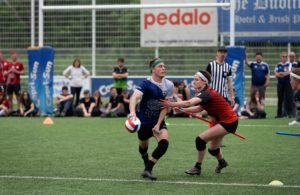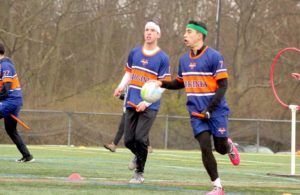- Rule, Britannia, no more?
- Unpopular Opinions: US Quadball Cup 2023
- Proven Contenders: University of Virginia
- Proven Contenders: Rutgers University
- Proven Contenders: University of Michigan
- Proven Contenders: Creighton University
- Different Perspectives: A Look Inside USA Ultimate
- Antwerp QC, Much of Belgian Core, Leaves Competitive Quidditch
Anatomy of a Loss
- By Kevin Oelze
- Updated: June 10, 2016
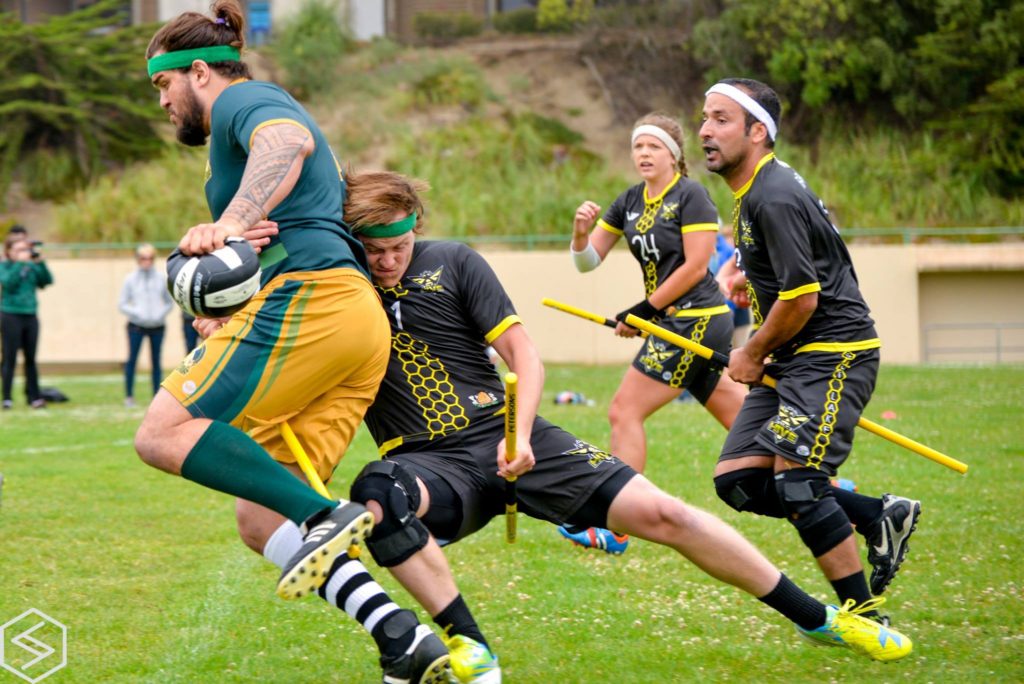
Credit: Seabass Photography
Over the weekend, the Salt Lake City Hive swept the San Francisco Argonauts in a matchup that many feel could swing second place in the MLQ West Division.
In spite of the final results, the Argonauts outscored the Hive in the first two games by a whopping 50 quaffle points in regulation. However, the Argonauts were unable to capitalize on their superior quaffle play and failed to close out any game with a win.
Why was San Francisco unable to secure a win, in spite of the aforementioned advantage? Did they just suffer in the seeker game? Were they just unlucky? When examining game footage, the answer is clear and it’s a lesson anybody who watches competitive League of Legends should already know: always know your win conditions and play for objectives that help you get to your win conditions.
For those of you unfamiliar with the most popular online computer game in the world, League of Legends has a very simple goal: destroy a particular building controlled by your enemy before they destroy yours. Despite the relative simplicity of the goal, there are a multitude of ways to accomplish it. You can build a team designed to simply defeat the other team in combat and barrel right through the opponents, or you could build a team designed to simply sneak around your opponent and prevent them from ever being able to actually fight you. Additionally, while only one objective determines the ultimate winner, there are plenty of smaller objectives which can help your team on its quest to destroy your opposition’s nexus. You can make similar links with quidditch: the ultimate goal is to outscore the opposing team at the end of the game, but there are smaller objectives along the way you can secure. Bludger control could be considered an objective, as could getting the score out of snitch range, simply scoring a goal or even drawing a card on the opposing team. In League, just like in quidditch, your ultimate success does not just rely on the skill of the players; the way you prioritize objectives can be just as important as skill.
In League, the concept of a “win condition” is critically important. Put simply, a win condition is the way a team must play if it wants to maximize its chances of victory. In quidditch, a win condition could be thought of in the same way. Practically speaking, this means the following: before a game starts, as a coach, you should have a picture in your head of what a winning game looks like: What has to happen in order for your team to win? This should account for the strengths and weaknesses of your team. If you know the opposing team well enough, this should also account for their strengths and weaknesses. A potential win may require the team to constantly bring beaters up aggressively, use superior chasing to get out of snitch range and eventually catch the snitch. From another team or from the same team in a different matchup, a very different but equally valid win condition could call for the team to hold beaters back defensively, do anything possible to hold in snitch range and use its superior seeking to win the game by pulling the snitch.
Here’s the thing that gets complicated: win conditions aren’t fixed. Sometimes even the best analysis can be wrong about identifying the win conditions. Sometimes the way the game flows causes the win conditions to change. These are fluid, and constantly having to reevaluate and correctly identify how your team needs to play in order to maximize its odds of winning is probably the biggest challenge a coach has to deal with in-game.
This brings me back to the first game of the Hive/Argonaut series. A reasonable analysis of the series going into the match may have read as such:
“The Hive is made up of mostly Crimson Elite and Utah State players who should have a good amount of instant chemistry. The Argonauts, on the other hand, have a lot of talent that is not accustom to playing together, but they should hold an advantage in the beating game with their star male beaters, even over the very well-regarded beating of Salt Lake City. If their beating can control the pitch, the Argonauts should be able to hold in snitch range. Even though Hive will have the advantage in the seeking game, the Argonauts may be able to mitigate that through superior beater play and give themselves a better chance at winning by a snitch pull.”
This analysis is understandable and excusable, but as the series’ results proved, it’s also wrong. Salt Lake City struggled mightily against the Argonauts’ defense and, while there were some chemistry difficulties, the Argonauts seemed to be clearly superior handling the quaffle with longer and better possessions. At the point where it became clear that San Francisco had an advantage in the quaffle game, the win conditions for the squad changed. No longer should they have been content to simply hang around the game and try to win on a snitch catch. Their new endgame should have been pushing Hive out of snitch range, which they actually did start to do, eventually opening up a 40-point lead before the snitch came onto the pitch. However, a failure to understand their win conditions at this point in a particularly disastrous sequence is ultimately what cost the Argonauts this game. Let’s take a look at the video.
- Score goals on high percentage plays in order to extend the lead
- Maintain long possessions to minimize Hive’s chances at scoring
- Do not allow Hive to score the quaffle
- Hold onto bludger control
Now let’s examine how well they actually play toward these objectives. Their first possession set up as such:
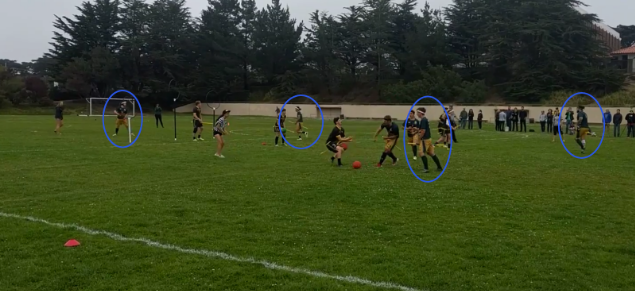
They’ve just set up bludger control, and it seems like they’re in a good position to set up for a long possession. Their four chasers are well spread, which makes it difficult for Salt Lake City to force a quick end to this possession. However, within four seconds of this shot being taken, keeper Dan Marovich attempts to pass to Nicte Sobrino through the double-team pressing on him, ignoring the open Andrew Covel to his left. While Sobrino is not covered by a chaser right now, the Hive’s lone armed beater is shading towards her and would almost certainly be able to close onto her before she could reel in the ball. However, the pass goes straight into the double-team of chasers and leads to a quick turnover. This is the exact type of play the Argonauts want to avoid—it leads to a quick possession which does not help them effectively drain the clock. Even if the pass was completed, it would not necessarily have been an easy goal. This is a poor job of playing towards the objectives that they wanted.
Salt Lake City is able to score on the next possession to close within snitch range, but the Argonauts quickly answer back on a pass from Marovich to chaser Kyle Pickett to stay out of snitch range. After this goals, the seekers are released, with the game finally crossing the 18-minute threshold. At that moment, the seeker is the least important win condition for San Francisco, but the Argonauts put themselves in a position to lose bludger control in order to try to beat Dan Howland, the Hive’s seeker.
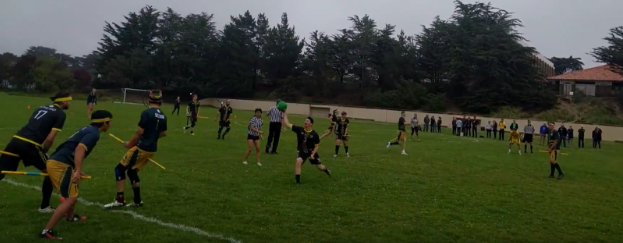
Thankfully for the home team, David Saltzman is barely able to roll his bludger back before he is beat in order to preserve bludger control. While George Williams thinks he has an opening for a drive, that is quickly thwarted by the presence of Miles, leading to what should be an extremely advantageous position for the Argonauts, because now the Hive have to make a difficult choice: while the seeker game may not be particularly meaningful for the Argonauts, it is crucial for Salt Lake City that they prevent the Argonaut seeker from catching the snitch. If they put beaters on the snitch, it massively opens up the quaffle game, but if they do not, they run a much higher risk of giving San Francisco a massive window for them to catch the snitch. If the Argonauts can avoid squandering their position just for a couple of minutes, they are likely to have pushed the Hive even further out of snitch range or secured the victory. Things even start looking good for the Argonauts right after this possession. Determined to not lose the game on a snitch catch, the Argonauts make an attempt to secure their most important objective by increasing their lead.
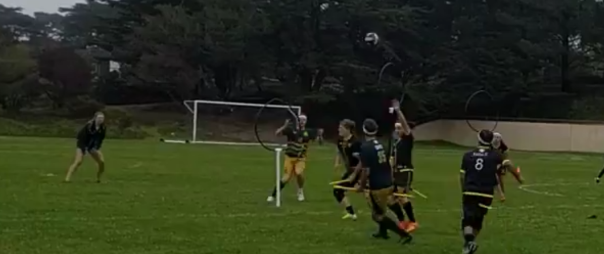
With all Hive beaters forward in the seeker game, Covel breaks down the field and sees that Pickett has gotten behind the defense for what should be an easy goal. Pickett pulls down the pass from Covel, but he makes a mistake and shoots at the wrong hoop as a crashing Williams is able to block the quaffle through the hoop. Still, this was a gamble worth taking: it was high reward, as an additional goal would almost certainly have been the final nail in the Hive’s coffin, and it was relatively low risk. While it does give Hive possession back, this is not in a good position for Salt Lake City to turn this into a fast break or easy goal, as the San Francisco beaters can easily be in position to stop anything. However, on the next Hive possession, things go horribly wrong for the Argonauts.
At this point, the Argonauts are playing a beater line of Miles and Saltzman. This possession begins with Saltzman pressuring the snitch even though San Francisco is on defense. He almost gets caught out and loses his bludger, but he is once again able to toss his bludger back to the hoops and recover it. However,this forces Miles and Saltzman to switch positions in their vertical beater set. Both are fantastic beaters, but if looking at individual strengths and weaknesses, you would say that Miles has a stronger arm and Saltzman is stronger at retaining bludger control by using his legs more effectively, which means—ideally—Saltzman plays the top of this set and Miles plays the role of back beater. The possession continues and Miles correctly exerts pressure on the quaffle as it is brought up, forcing Salt Lake City in a poor offensive position, but a large number of San Francisco mistakes soon put the Hive back in a position where they can win the game.
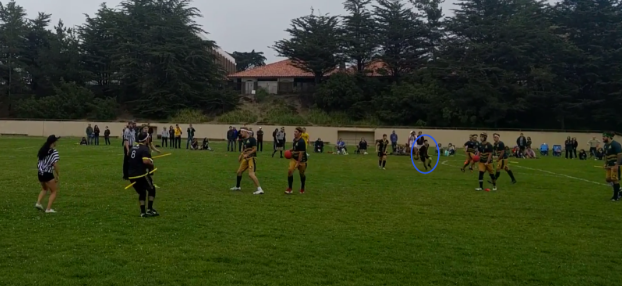
In this image, we have Miles pressuring the quaffle while Saltzman hangs back. Unbeknownst to Saltzman, though, a Hive beater is creeping behind him ready to steal his bludger. San Francisco makes several mistakes here. Firstly, nobody on the bench warns Saltzman that a beater is approaching him. This is an important duty of the bench and a huge neglect by the entire team. Secondly—and more minorly, in my opinion)—Saltzman is positioned aggressively but essentially doing nothing. He is not really pressuring anyone, and he leaves himself in a position where if he happens to get hit, he has essentially no chance of retaining bludger control. He could be achieving the same thing while standing much closer to the hoops. Predictably, Saltzman is going to get hit, which should yield bludger control for Hive. However, stopping the Hive from scoring remains the most important objective here, which means when Miles turns to try to recover bludger control, he makes a large mistake.

Miles turns to try to recover bludger control, and Salt Lake City’s Mohammadreza Faraji sees the opportunity unfolding. As Miles turns for a difficult—although very much within his capability—beat, Faraji takes off and begins his run at the hoops. Miles’s throw is on target, but the Hive’s Paul Davis sees it coming and is able to dodge it before it hits him, causing Miles’s bludger to roll far off the pitch. The Hive now have bludger control, and the only bludger the Argonauts have access to is far off pitch, which gives them plenty of time to score in a no-bludger situation against a relatively poor on-ball chaser defense lineup of San Francisco. Faraji charges the hoops, forcing Marovich to leave the hoops and confront him. This is a moment of opportunity for the Argonauts, since if Marovich can quickly dispatch Faraji, he has no real support from the rest of the Hive.
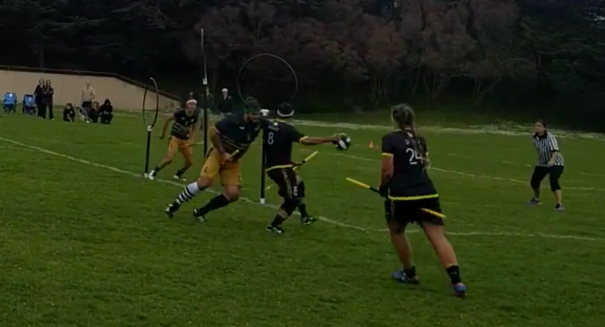
Unfortunately, Marovich’s form is off, and he engages on this tackle too high, which causes him to end up around Faraji’s neck. At this point, a goal is essentially guaranteed for Hive, as a card is forthcoming on Marovich, which will cause the quaffle to reset to right near the hoops with no defense. Even so, Faraji absorbs the hit, going to the ground, but finding a charging Williams for an advantaged goal that closes the game to back inside of snitch range.
At this point, the disaster is complete for the Argonauts. In this short time period, they now have lost their out of snitch range lead and they have lost bludger control, as the play is going to be blown dead to award the card. The Argonauts make an attempt to score on the next possession, but Marovich is taken down by Williams in space, and the keeper does not see a wide open Covel for an easy goal.
The Argonauts are now no longer able to safely ignore snitch play. From this point in the game, nearly all beaters are focused on the seeker game, which turns the game into continued no bludger situations that slightly favor Salt Lake City. Ultimately, San Francisco is in a place where they can still win the game, but they are no longer in a place where they are even favorites. The seeker advantage the Hive enjoys with Howland and Edgar Pavlovsky is enough that the Argonauts should be considered underdogs, and the game plays out in the predictable manner: a heroic run of play by Salt Lake City’s Paul Davis enabled their seeker to have a solid uninterrupted minute with the snitch, and the Hive won on a snitch catch to take a 10 point win that could have easily been avoided if the Argonauts players and coaches all understood their win conditions and played appropriately.
Related Posts
About Kevin Oelze
Kevin is the co-founder and technical director of The Eighth Man. In his off time, he masquerades as a software engineer, and actively participates in karaoke duels. Despite the rules calling for Jason Mraz-only duels, his go-to song is ""Brighter than Sunshine"" by Aqualung.

